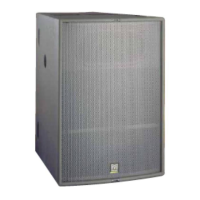If the sky remains clear after sunset, the ground will cool and draw heat from the air
in contact with it. Air nearest the ground may get cooler than the air above it. In the
absence of wind, this cool air may stay near the ground on a still night.
The same "inverse temperature gradient" can form above ice rinks and in most indoor
venues. Sound will now travel slower near the ground and faster higher up causing its
path to be tilted downwards.
2a.4Relative humidity effects
Air absorption is quoted in dB/m and occurs over and above the usual sound pressure
level changes caused by an expanding wavefront quoted in dB/doubling of distance.
Air absorption changes with relative humidity and temperature but these changes are
complex - particularly where the humidity is low and the temperature varies a lot.
60m
50m
40m
30m
20m
10m
0˚C 10˚C 20˚C
0m
Temperature
inversion
30m
20m
10m
0m
0m10m20m30m40m50m60m70m80m90m
Sound path tilting down indoors due to high level heating or low
level cooling (eg. ice rink) or outdoors due to cooling ground
Cooler
Warmer
All material © 2007. Martin Audio Ltd. Subject to change without notice.

